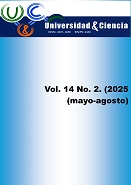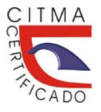Antimicrobial effect of Morinda royoc L. during acclimatization of Ananas comosus ‘MD-2’ vitroplants
DOI:
https://doi.org/10.5281/zenodo.15677899Keywords:
anthraquinone, pineapple, phytopathogen, rootsAbstract
Introduction: the use of natural products from plants in modern agriculture is a worldwide trend, due to its benefits in food security. However, in the cultivation of Ananas comosus var comosus, the control of phytopathogenic diseases is carried out mainly through synthetic chemical pesticides. In this context, Morinda royoc L. is recognized for its marked bioactivity and high added value, attributed mainly to anthraquinones as major compounds in roots Objective: to determine the preventive antimicrobial effect of the hydroethanolic extract of M. royoc roots in pineapple vitroplants ‘MD-2’ in the acclimatization and nursery phase. Methods: the application of the extract was included in the disease management and control program of the crop, according to the Technical Instructions of the cultivar at Centro de Bioplantas. The extract was applied in the initial acclimatization phase of the vitroplants and subsequently with applications every 15 days. Seven treatments were designed according to different combinations of the extract and synthetic chemical fungicides. The evaluation of morpho-physiological indicators and the survival rate up to 150 experimental days was carried out. Results: three of the treatments where the extract was applied, no dead plants or plants with disease symptoms were observed, which coincided with the chemical control. Conclusion: M. royoc extract showed a preventive antimicrobial effect on vitroplants up to the nursery phase, comparable to when synthetic fungicides were used. It was demonstrated that the application of the extract until 150 days did not affect the growth and morphological development of the plants.
Downloads
References
Amar, A., Tong, P., y Casey N. (2015). The MD2 ‘Super Sweet’ pineapple (Ananas comosus). UTAR Agriculture Science Journal, 1(4),14-17.
Baque, M. A., Shiragi, M., Lee, E., y Paek, K. (2012). Elicitor effect of chitosan and pectin on the biosynthesis of anthraquinones, phenolics and flavonoids in adventitious root suspension cultures of' Morinda citrifolia (L.). Australian Journal of Crop Science, 6(9), 1349-1355.
Cid, G., Linares, C., Rivas, M., Quiñones, J., y Capdesuñer, Y. (2020). Actividad antimicrobiana de extractos crudos bioactivos de raíces de Morinda royoc L. crecidas en Cuba. Revista de Protección Vegetal, 35(1), 1-13.
Daquinta M., y Benegas R. (1997). Brief review of tissue culture of pineapple. Newsletter Pineapple International Society Horticultural Sciences 3, 7-9.
DeGenring, L., Peter, K., y Poleatewich, A. (2023). Integration of Chitosan and Biopesticides to Suppress Pre-Harvest Diseases of Apple. Horticulturae, 9(6), 707.
DeLiberto, S., y Werner, S. (2016). Review of anthraquinone applications for pest management and agricultural crop protection. Pest Manag Sci., 72, 1813-1825.
Escalona M., Lorenzo J., González B., Daquinta M., Borroto C., y González J. (1999). Pineapple micropropagation in temporary immersion systems. Plant Cell Reports, 18(9), 743-748.
FAO. (2020). Análisis del mercado de las principales frutas tropicales. Panorama general de febrero de 2020.
Holb, I. (2009). Fungal disease management in environmentally friendly apple production–a review. Climate change, intercropping, pest control and beneficial microorganisms, 219-292.
Langa, N., Sanchez, E., Buzon, L., Gonzalez, V., Casanova, J., Martin, J., y Martin, P. (2021). Activity of anthracenediones and flavoring phenols in hydromethanolic extracts of Rubia tinctorum against grapevine phytopathogenic fungi. Plants, 10(8), 15-27.
Lawrence, S., Robinson, H., Furkert, D., Brimble, M., y Gerth, M. (2021). Screening a natural product-inspired library for anti-Phytophthora activities. Molecules, 26(7), 1-9.
Linares, C. Cid, G., Capdesuner, Y., Buchelle, M., Martinez, M., Scheer, C., y Quiñones, J. (2023). Optimization of the process for obtaining Morinda royoc crude extract bioactive against phythopathogens. Vegetos, 37(4), 1336-1345. https://doi.org/10.1007/s42535-023-00675-5.
Mesa, V., Marín, P., Ocampo, O., Calle, J., y Monsalve, Z. (2019). Fungicidas a partir de extractos vegetales: una alternativa en el manejo integrado de hongos fitopatógenos. RIA. Revista de investigaciones agropecuarias, 45(1), 23-30.
Murashige, T., y Skoog, F. (1962). A revised medium for rapid growth and bio assays with tobacco tissue cultures. Physiologia plantarum, 15(3), 473.
Oculi, J., Bua, B., y Ocwa, A. (2019). Quantification of yield loss to pineapple heart rot disease on pineapple cultivars in Uganda. Journal of Animal & Plant Sciences, 41(1), 6784-6792. https://doi.org/10.35759/JAnmPlSci.v41-1.5
Paula, S. de, Holz, S., Souza, D., y Pascholati, S. (2021). Potential of resistance inducers for soybean rust management. Canadian Journal of Plant Pathology, 43(2), 298-307.
Pérez Gómez, L., Capote Betancourt, I., Nápoles Borrero, L., Pina Morgado, D., Linares Rivero, C., Rivas Paneca, M., y Pérez Martínez, A. T. (2019). Efecto del extracto acuoso foliar de moringa en la fase inicial de aclimatización de piña. Cultivos Tropicales, 40(1), 1-23.
Pérez Vicente, L., Santana, Y., García, O., Lovain, Y., Pérez Miranda, M., y Rodríguez, J. (2017). Eficacia de fungicidas antioomycetes en la desinfección de hijos de piña MD2 para el control de Phytophthora nicotianae var. Parasítica Dastur. Revista Protección Vegetal, 32(2), 1-13.
Pham, D. Q., Pham, H., Han, J., Nguyen, T., Nguyen, H., Nguyen, T., Nguyen, T., Ho, C., Pham, H., y Vu, H. (2021). Extracts and metabolites derived from the leaves of Cassia alata L. exhibit in vitro and in vivo antimicrobial activities against fungal and bacterial plant pathogens. Industrial Crops and Products, 166, 113-465.
Puentes Díaz, C., Tarazona Velasquez, R., y Moreno I. (2022). Prevalencia de pudriciones basales en cultivos de piña (Ananas comosus (L.) Merr.) MD2 en Colombia. Revista de Protección Vegetal, 37(1), 1-9.
Quintal, C., Valencia, L., Chávez, A., Rangel, J., y Moo, R. (2022). A Morinda royoc root extract and fractions exhibit antigiardial activity without affecting cell viability. Iranian Journal of Parasitology, 17(2), 259-267.
Schulte, U, El-Shagi, H., y Zenk, M. (1984). Optimization of 19 Rubiaceae species in cell suspension cultures of Cinchona ledgeriana. Plant Cell Rep. 3, 51-54.
Sahu J., y Sahu RK. (2013). A review on low cost methods for in vitro micropropagation of plant through tissue culture technique. UK Journal of Pharmaceutical and Biosciences, 1(1), 38-41.
Shang, X., Zhao, Z., Li, J., Yang, G., Liu, Y., Dai, L., Zhang, Z., Yang, Z., Miao, X., y Yang, C. (2019). Insecticidal and antifungal activities of Rheum palmatum L. anthraquinones and structurally related compounds. Industrial Crops and Products, 137, 508-520.
Schulte, U., El Shagi, H., y Zenk, M. (1984). Optimization of 19 Rubiaceae species in cell suspension cultures of Cinchona ledgeriana. Plant Cell Rep, 3, 51-54.
Villalobos, A., González Olmedo, J., Santos, R., y Rodríguez, R. (2012). Morpho-physiological changes in pineapple plantlets [Ananas comosus (L.) Merr.] during acclimatization. Ciência agrotecnologia, 36(2), 624-630. doi:10.1590/S1413-70542012000600004.
Wang, J., Xu, S., Mei, Y., Cai, S., Gu, Y., Sun, M., Liang, Z., Xiao, Y., Zhang, M., y Yang, S. (2021). A high-quality genome assembly of Morinda officinalis, a famous native southern herb in the lingnan region of southern China. Horticulture Research, 8(135), 1-16.
Zaker, M. 2016. Natural plant products as eco-friendly fungicides for plant diseases control-A review. The Agriculturists, 14(1), 134-141
Downloads
Published
How to Cite
Issue
Section
License
Copyright (c) 2025 Universidad & ciencia

This work is licensed under a Creative Commons Attribution-NonCommercial-ShareAlike 4.0 International License.





















